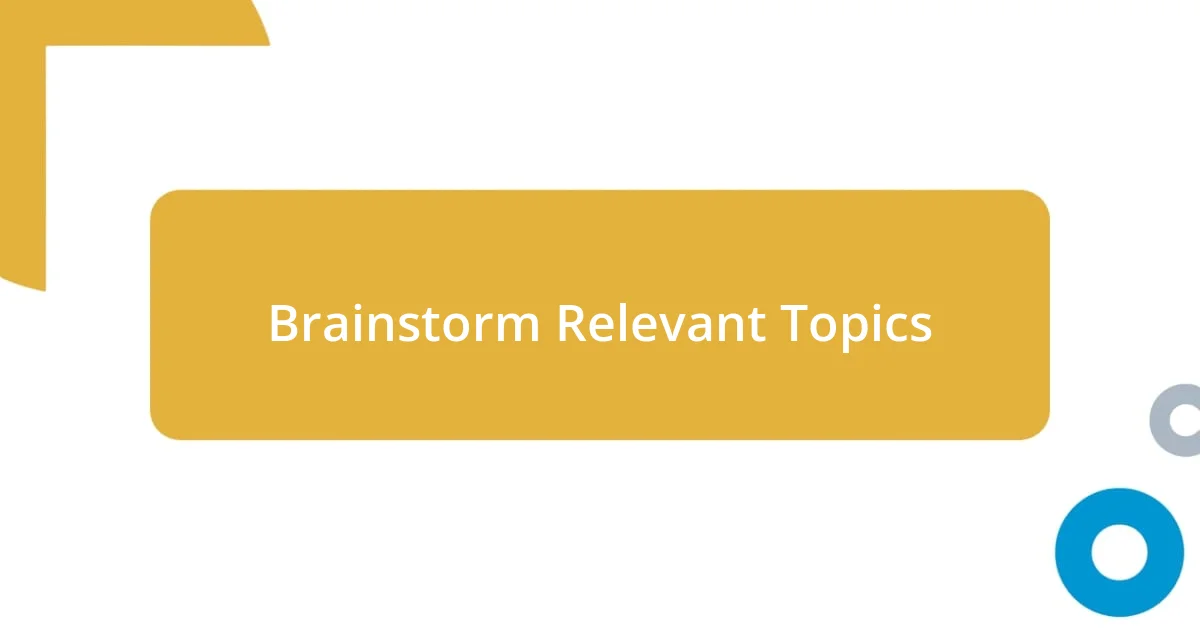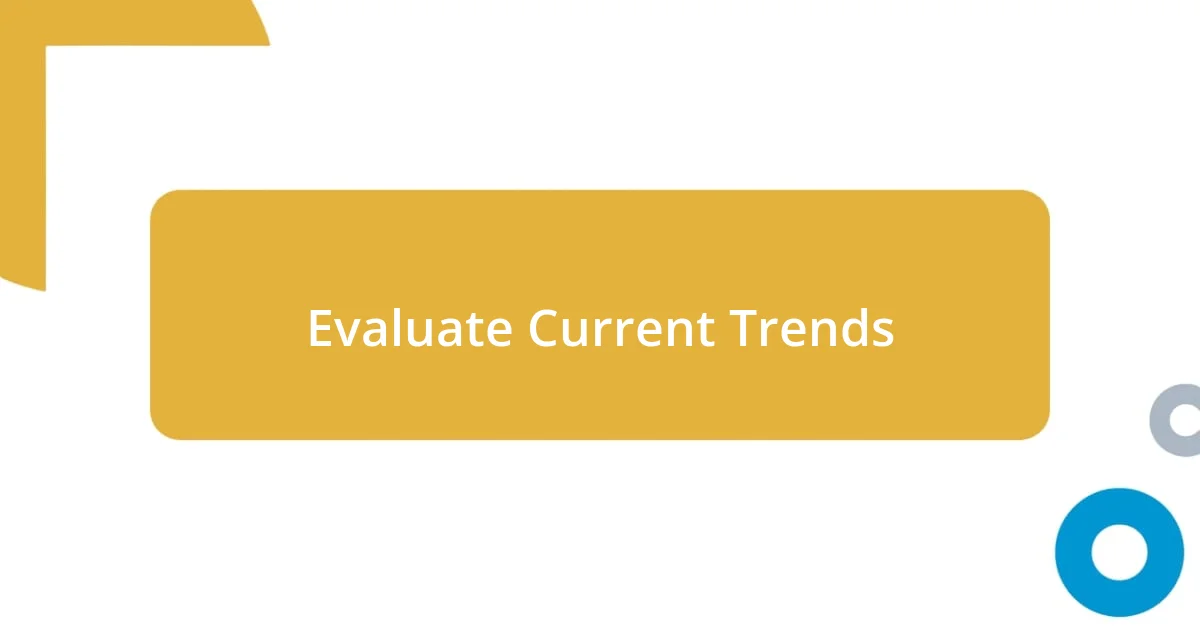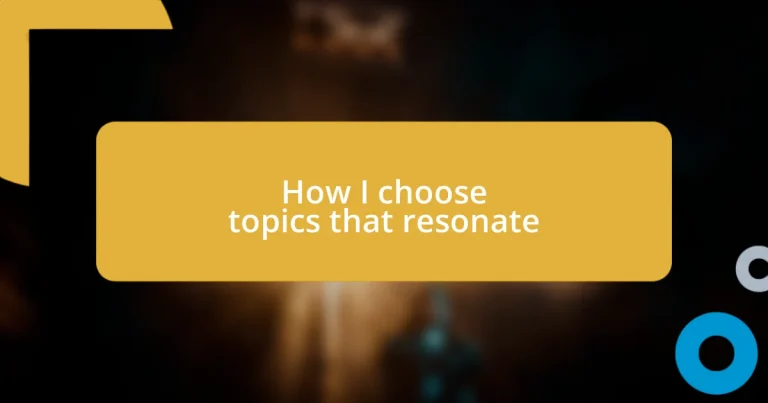Key takeaways:
- Understanding audience needs through engagement and feedback is essential for creating resonant content.
- Brainstorming in relaxed settings and collaborating with others can uncover unique and relevant topic ideas.
- Testing topics through social media engagement and analyzing performance metrics helps refine content strategies effectively.

Identify Your Audience Needs
Identifying your audience’s needs is the cornerstone of resonating content. I remember when I first started writing; I would just throw ideas out there, hoping something would click. It wasn’t until I began to truly listen and engage with my audience through surveys and comments that I realized how crucial it is to understand what they genuinely care about. What challenges are they facing? What questions keep them up at night?
One time, I posted a piece on a popular topic, only to find that my readers were yearning for something entirely different—practical tips on a related issue. That experience taught me a valuable lesson: your audience isn’t just a statistic; they’re individuals with unique needs and aspirations. By actively engaging and seeking feedback, I learned to tailor my writing to ensure it aligns with their interests.
Analyzing the data has also played a significant role in understanding my audience. I often delve into social media analytics and engagement metrics to see where my content shines. Seeing which posts get the most traction motivates me to explore those themes even further. After all, when you connect with your audience on a deeper level, the content becomes more than just words on a page; it becomes a dialogue that fosters community and trust.

Brainstorm Relevant Topics
To brainstorm relevant topics, I often find it helpful to generate ideas in a relaxed environment, away from distractions. I’ll take a walk or even just sit down with a cup of coffee. This process can lead to unexpected insights; for instance, I once jotted down a few random thoughts about a hobby that turned into a series of articles. It’s interesting how inspiration can strike when you least expect it!
I also recommend using collaborative brainstorming sessions with peers. Sharing ideas can spark creativity and uncover topics you might not have considered on your own. I recall a group brainstorming session where a simple conversation about a trending issue led to a collaborative project that was incredibly well-received. It’s amazing how bouncing ideas off others can uncover the hidden gems that resonate with a wider audience.
Lastly, keeping a running list of trending topics or “evergreen” themes helps maintain focus while brainstorming. I often revisit sites like Google Trends or BuzzSumo to gauge what’s currently grabbing people’s attention. One time, I noticed a surge in interest around a specific technology trend that inspired me to craft multiple pieces. By staying informed about these currents, you position yourself to produce content that not only resonates but also feels timely.
| Brainstorming Method | Pros |
|---|---|
| Solo Reflection | Encourages unique insights and personal connection |
| Collaborative Sessions | Sparks creativity through diverse perspectives |
| Trend Analysis | Ensures timely and relevant topics |

Evaluate Current Trends

Evaluate Current Trends
Understanding current trends is essential for choosing impactful topics. I often find myself scrolling through social media or checking out the latest articles to see what’s gaining traction. One memorable instance was when I noticed a rising interest in sustainable living. It struck a chord with me personally, as I had recently adopted some eco-friendly practices myself. This insight led me to create a piece that combined my journey with practical tips, and the response was overwhelming. It felt rewarding to tap into a trend that not only resonated with others but also reflected my own values.
To efficiently evaluate trends, I’ve developed a simple approach by employing these strategies:
– Social Media Scanning: I frequently browse platforms like Twitter and Instagram, keeping an eye on hashtags that indicate popular discussions.
– Google Trends: This tool is fantastic for seeing what people are searching for in real time; I often use it for inspiration.
– Industry Reports: I subscribe to newsletters from industry leaders where I can identify shifts and emerging topics that might interest my audience.
– Engagement Metrics: Examining my previous content’s performance allows me to spot patterns over time, guiding me toward future writing choices.
By using these methods, I’m able to connect with what’s relevant today, ensuring that my content doesn’t just echo my voice but also reflects what my audience is buzzing about.

Assess Personal Passion and Expertise
I believe that assessing personal passion and expertise is crucial when choosing topics that truly resonate. For me, the topics I’m most passionate about often stem from my own experiences. I remember when I first started exploring mental health topics, driven by my struggles and the insights I gained along the way. That personal connection made writing about it not only engaging but also meaningful. Does this resonate with you? Finding that intersection between what fascinates you and where you feel knowledgeable can set a solid foundation for impactful content.
Reflecting on my expertise also enhances my writing’s depth. I recall an experience where I was hesitant to write about digital marketing. It felt daunting at first, but I realized I had years of experience in the field. The moment I embraced this expertise, my confidence skyrocketed. I started to turn my knowledge into relatable content, sharing both successes and challenges. When I think back, I can see how this authentic approach attracted readers—it’s about sharing a journey, not just delivering dry facts.
I encourage you to explore how your passions align with your expertise. Think about moments in your life where you felt genuinely excited or knowledgeable. When does time fly for you while doing something? Those moments might be the goldmines for topic ideas. I’ve learned that authenticity shines through when I write from a place of both passion and knowledge, and I truly believe this connection can make all the difference in engaging your audience.

Seek Feedback and Insights
When it comes to seeking feedback and insights, I’ve found that reaching out to my audience can be incredibly rewarding. A while ago, I decided to create a survey after noticing a lull in engagement on my blog. The responses were eye-opening! It turned out that my readers craved more content on personal growth. This revelation not only informed my future posts but made me feel more connected to my audience. Have you ever thought about how just a few questions could unlock a treasure trove of ideas?
I’ve also learned the value of discussing my ideas with fellow writers and mentors. During a brainstorming session with friends, I mentioned a topic I was excited about, only to discover it was not resonating as much as I thought. Their honest feedback opened my eyes to different perspectives. That particular conversation sparked a new direction, leading me to explore the nuances of the topic with a fresh lens. Sometimes, those candid conversations are just what you need to uncover hidden gems that will truly resonate.
Additionally, platforms like online communities and social media can serve as great sounding boards. When I shared a draft of an article on my team’s Slack channel, I was surprised by how a couple of small comments shifted my approach entirely. One colleague highlighted the importance of incorporating storytelling, which encouraged me to weave in my own experiences. It’s incredible how collective insights can refine and elevate your content, transforming it from good to unforgettable. Have you tapped into these resources? They might just inspire topics that resonate with you and your audience alike!

Test Topics Through Engagement
Testing topics through engagement is a strategy I find invaluable. Recently, I shared a few ideas on Instagram, simply asking my followers what intrigued them most. The enthusiasm for one particular concept, about the challenges of remote work, was overwhelming. It made me realize that my audience yearned for relatable content that mirrored their own experiences. Have you ever tried gauging interest in this way? It can lead to delightful surprises!
In my journey, I’ve often participated in webinars and Q&A sessions, where I could test my ideas in real-time. During one particular event, I introduced a topic on work-life balance and noticed an explosive engagement; attendees were eager to share their stories. This interaction not only validated my topic choice but gave me personal anecdotes I could weave into future posts. It’s funny how a simple conversation can breathe life into an idea, isn’t it?
I also utilize analytics to assess how my content performs, paying attention to likes, shares, and comments. Once, I observed that an article on self-care practices received far more engagement than my well-researched pieces. This discrepancy taught me to embrace the lighter, relatable topics alongside the heavier, more serious ones. Do you track your content’s performance? It might just reveal what your audience connects with most deeply, and those insights can help refine your focus when selecting future topics.

Refine and Analyze Results
Refining and analyzing the results after implementing feedback and testing topics is a crucial next step. For me, it often means diving deep into metrics and comments to unearth patterns. A while back, I took a closer look at the analytics for a post on overcoming creative blocks, and I discovered that readers were not just liking it; they were sharing it with their networks, which clued me into its significance. Isn’t it fascinating how numbers can tell a story of their own?
I’ve also cultivated a habit of revisiting my content after a few weeks to gauge lingering interest. One time, I repurposed an underperforming article on productivity into a more engaging format, intertwining personal anecdotes about my own struggles with procrastination. The new angle sparked interest, encouraging more readers to share their own journeys. Have you ever considered how revisiting past content could breathe new life into it?
Additionally, collecting responses from surveys and comments plays a pivotal role in my analysis. Once, I received a suggestion to write about overcoming self-doubt, something deeply personal to me. While I hesitated at first, the emotional weight behind it urged me to explore the topic. After publishing, the flood of messages from readers sharing their own battles with self-doubt reminded me of the captivating power of vulnerability. It’s moments like these that truly highlight the importance of refinement – not just refining the topics, but also refining how we connect with our audience.














